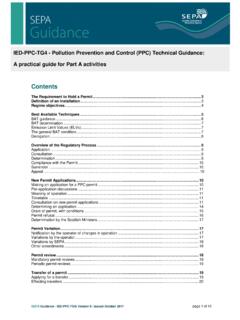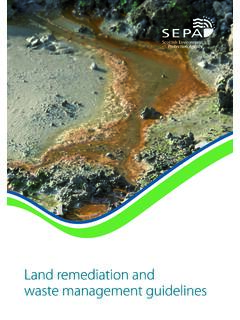Transcription of Temporary Construction Methods
1 First edition, March 2009 Engineering in the Water Environment Good Practice Guide Temporary Construction Methods Page 1 of 59 Your comments SEPA is committed to ensuring its Good Practice Guides are useful and relevant to those carrying out activities in Scotland s water environment. We welcome your comments on this Good Practice Guide so that we can improve future editions. A feedback form and details on how to send your comments to us can be found at the back of this guide in Appendix 1. Page 2 of 59 Engineering in the Water Environment Good Practice Guide: Temporary Construction Methods First edition, March 2009 (Document reference: WAT-SG-29) Contents 1 Introduction 3 What s included in this Guide? 4 2 Impact of the Construction phase on the water environment 6 Pollution 6 Damage to habitats 7 3 Good practice guidance 9 Planning and site set-up 9 Site clearance 12 Minimise run-off of contaminated water 14 Isolation of works area 20 De-watering of isolated area 37 Treatment and/or disposal of contaminated water 39 Temporary river crossings 43 Re-instatement of bed and banks 50 Appendix 1: Feedback form Good Practice Guide WAT-SG-29 57 Page 3 of 59 1 Introduction This document is one of a series of good practice guides produced by SEPA to help people involved in the selection of sustainable engineering solutions that minimise harm to the water environment.
2 This Guide is intended for use by those considering engineering activities in rivers or lochs and SEPA staff. SEPA expects all new engineering activities authorised under the Water Environment Water Environment (Controlled Activities) (Scotland) Regulations 2011 ( CAR ). also known as the Controlled Activities Regulations or CAR to follow good practice. Good practice is defined as the course of action that serves a demonstrated need and is sustainable (ie the work is justified and the chosen design is effective), while minimising ecological harm and at a cost that is not disproportionately high. Applicants proposing to undertake an engineering activity will be expected to demonstrate to SEPA that good practice has been adopted (see box below).
3 Part of this involves ensuring that harm to the environment is minimised during the Construction phase (question 5 below). This Guide is designed to help applicants: ensure good practice is carried out during the Construction phase for all engineering activities in the water environment; help provide the information required in the CAR application form. Summary of SEPA good practice tests 1. have you demonstrated a need for the proposed activity? 2. have you considered appropriate alternative approaches? 3. Does the proposal represent the best environmental option? 4. Is the activity designed appropriately? 5. have all necessary steps been taken to minimise the risk of pollution and damage to habitat or flora/fauna during Construction ? This document is not intended as a technical design manual.
4 It is important to recognise that any engineering works must be designed to suit site-specific conditions. This document addresses the environmental aspects that should be considered when undertaking a project. Page 4 of 59 Under the Controlled Activities Regulations new engineering activities in Scotland s rivers, lochs and wetlands require an authorisation from SEPA. More information is available in the CAR Practical Guide Oil must be stored in accordance with the Water Environment (Oil Storage) (Scotland) Regulations 2006. The Regulations apply to any kind of oil including petrol, diesel, mineral oil, heating oil, lubricating oil, waste oil, vegetable and plant oil. More information on these regulations and when they apply can be found on the SEPA website What s included in this Guide?
5 This Guide focuses on Temporary Construction works required when working in rivers or lochs. It does not cover pollution prevention measures for the wider Construction site. There is already considerable guidance (see box below) on preventing pollution from Construction sites, which should be considered along with the guidance given in this Guide. The good practice guidance given in Section 3 of this Guide covers the following tasks: planning and site set-up; site clearance; minimising run-off; isolation of works area; de-watering of isolated area; treatment/disposal of contaminated water; Temporary river crossings; reinstatement of bed/banks. Colour coded boxes in this guide highlight key information. Green boxes provide summaries of important points.
6 Blue boxes provide details of other useful sources of information. Orange boxes provide summaries of regulatory information. Guidance on preventing pollution from Construction sites CIRIA publications available from Control of Water Pollution from Construction Sites Guide to Good Practice (SP156) Control of Water Pollution from Construction Sites Guidance for Consultants and Contractors (C532) Control of Water Pollution from Linear Construction Projects Technical Guidance (C648) Control of Water Pollution from Linear Construction Projects Site Guide (C649) Environmental Good Practice Site Guide (C650) The SUDS Manual (C697) Site Handbook for the Construction of SUDS (C698) Pollution prevention guidance published jointly by Environment Agency, SEPA and Environment and Heritage Service: Getting Your Site Right.
7 Industrial and Commercial Pollution Prevention. Pollution Prevention Guideline (PPG) 5: Works and Maintenance In or Near Water Pollution Prevention Guideline (PPG) 6: Working at Construction and Demolition Sites Pollution Prevention Guideline (PPG) 21: Pollution Incident Response Planning Pollution Prevention Guideline (PPG) 18: Managing Fire Water and Major Spillages Page 5 of 59 Page 6 of 59 2 Impact of the Construction phase on the water environment Although the Construction phase of any project is short term compared with the permanent works that are being built, the risk of pollution and damage to the water environment during this phase is very high. These risks are summarised below. Pollution Scotland generally experiences the highest annual rainfall in the UK.
8 But within Scotland rainfall can vary considerably; in parts of the West Highlands annual rainfall can be up to 3m compared to less than 800mm in parts of the east coast. This is an important consideration for Construction works in Scotland, as rainfall increases the risks of pollution and damage to the water environment also increase. Rainfall and associated surface water run-off during Construction works can mobilise and transport pollutants such as sediment, oils, chemicals and other building materials into the water environment causing harm to plants and animals. Heavy rainfall can also flood excavations and other work areas which subsequently require draining or de-watering. When working in or near rivers, Construction sites are more at risk of flooding from rising river levels.
9 Pollution from sediment and other pollutants can come from a number of sources on Construction sites (see box below). Potential sources of pollution on Construction sites Direct disturbance of the banks and bed of rivers and lochs De-watering of excavations Run-off from exposed ground and material stockpiles Run-off from roads and haul routes and river crossings Plant washings/washing areas Fuel and chemical storage/refuelling areas Leaking/vandalised equipment Impacts of pollution can include the following. Sediment pollution can smother important river habitats such as fish spawning habitats (see Figure 1). Pollution from fuels and other chemicals can have a variety of effects on fresh water ecology and can lead to fish and invertebrates being killed in lochs and along long lengths of river.
10 Cement pollution of waters results in high alkalinity and raises the pH, which can be toxic to aquatic life. Even very small amounts of material can be a pollutant. For example, five litres of oil can disperse to cover an area of water the size of four football pitches. Page 7 of 59 All these forms of pollution can also render receiving waters unsuitable for potable or industrial abstraction, fish farming, angling, agricultural stock watering, and general amenity/tourism. Figure 1 X Poor practice on a Construction site leading to polluted surface water run-off Damage to habitats Important habitats, including protected habitats and species, can be lost during the Construction phase both through direct loss during site clearance (see Figure 2) or indirectly due to loss through pollution and/or disruption.









